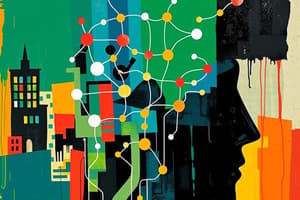Podcast
Questions and Answers
Questions are hidden until you start the quiz
Flashcards
What is AI?
What is AI?
Artificial Intelligence (AI) is a computer program that thinks, learns, and makes decisions like a human.
AI in Public Sector
AI in Public Sector
AI enhances public service delivery and facilitates data-driven policy making, addressing societal challenges.
Use Case: Rural Transportation Planning
Use Case: Rural Transportation Planning
AI analyzes road data and traffic trends to support funding requests and prioritize projects.
Use Case: Community Policing
Use Case: Community Policing
Signup and view all the flashcards
Grant Application Assistance
Grant Application Assistance
Signup and view all the flashcards
AI Skills Training
AI Skills Training
Signup and view all the flashcards
Data-Driven Policy Making
Data-Driven Policy Making
Signup and view all the flashcards
Shadow AI
Shadow AI
Signup and view all the flashcards
Data Privacy in AI
Data Privacy in AI
Signup and view all the flashcards
Ethical Use of AI
Ethical Use of AI
Signup and view all the flashcards
Staff Training for AI
Staff Training for AI
Signup and view all the flashcards
Cost-Benefit Analysis in AI
Cost-Benefit Analysis in AI
Signup and view all the flashcards
Challenges in AI Adoption
Challenges in AI Adoption
Signup and view all the flashcards
Organizational AI Assessment
Organizational AI Assessment
Signup and view all the flashcards
Fostering Innovation Culture
Fostering Innovation Culture
Signup and view all the flashcards
Public Trust in AI
Public Trust in AI
Signup and view all the flashcards
Training and Development
Training and Development
Signup and view all the flashcards
Knowledge Sharing
Knowledge Sharing
Signup and view all the flashcards
Data Hierarchy
Data Hierarchy
Signup and view all the flashcards
Data Gathering
Data Gathering
Signup and view all the flashcards
Deep Learning
Deep Learning
Signup and view all the flashcards
Generative AI
Generative AI
Signup and view all the flashcards
Unstructured Data
Unstructured Data
Signup and view all the flashcards
Structured Data
Structured Data
Signup and view all the flashcards
Model Evaluation
Model Evaluation
Signup and view all the flashcards
Study Notes
AI in the Public Sector
- AI is a type of computer program designed to think and learn, making decisions and performing tasks, such as analyzing data, solving problems, or providing recommendations.
- AI has significant potential to enhance employee productivity in public sector organizations.
- A study by MIT Sloan found participants using AI tools experienced a 38% increase in performance compared to those without assistance.
- With guidance on AI tools usage, performance increased by 42.5%.
- Employee time can be redirected to more complex tasks by using AI.
- For maximizing benefits, proper training and integration of AI tools are essential.
Presentation Overview
- Presentation will cover the role of AI in the public sector, AI use cases, implementation, pricing of AI tools, public sector usage surveys, and best practices.
- The presentation will also include discussion of the data development story, generative AI overview, cost and type models, required skills, optional resources, and wrap-up.
AI's Transformative Potential
- AI can enhance public service delivery through efficiencies.
- Data-driven policy making and governance can improve through AI.
- AI can address societal challenges with predictive analytics.
- Multiple applications of AI in public services are possible.
Use Cases
- Public and private sectors have common everyday use cases.
- AI-based workforce training can improve skills in various sectors.
- Specialized training in AI can be developed once core skills are established.
Public Sector Use Cases (Examples)
- Rural Transportation Planning: AI summarizes road conditions, analyzes traffic trends, and visualizes data for funding requests and prioritization of projects.
- Community Policing: AI analyzes crime trends, detects hotspots, and integrates community feedback to allocate resources effectively.
- Grant Application Assistance: AI identifies funding opportunities, drafts applications, and tracks deadlines.
Private Sector Use Cases (Examples)
- Customer Service Automation: AI handles routine customer inquiries, processes transactions, and provides real-time support, freeing up employees for complex issues needing human interaction.
- Supply Chain Optimization: AI analyzes inventory and sales to predict demand and reduce waste, ensuring optimal stock levels.
- Customer Feedback Analysis: AI reviews customer feedback to highlight strengths in the business, leading to improvements in customer service and products/services.
Success Stories
- Generative AI has the potential to enhance employee productivity in public sector organizations.
- Study participants using AI tools experienced a notable 38% performance increase.
- When using AI tools and receiving guidance, the performance increase was 42.5% higher.
Why AI Implementation Can Fail
- Top 5 reasons AI adoption can fail include rushing to adopt without strategic thought, lack of quality data, poor management, lack of effective cloud infrastructure, and unrealistic leadership expectations.
Public Sector AI 2024
- A significant number of public sector organizations are adopting AI technologies, with a notable focus on generative AI.
- 12% already use integrated Generative AI technologies.
- 30% plan to adopt generative AI in the next 1-2 years.
- Primary motivations include improving operational efficiency, enhancing communications, advancing education/workforce development, and improving citizen services.
- A majority of leaders (85%) need a trusted partner to successfully adopt Generative AI.
Elected Official AI Concerns
- Concerns include bias and fairness issues in AI systems, ensuring transparency in AI decision-making, making ethical considerations, safeguarding responsible use of AI, and evaluation of AI effects on local employment.
NACO AI Compass - Use Frequency
- Shows use frequency of AI tools in personal and work life.
- Charts usage of various specific AI tools in both personal and work settings.
NACO AI Compass - Functional Area Use
- Lists areas in operations most likely to benefit from generative AI use, with number of respondents for each area.
League of Cities AI Adoption
- Pie charts depict the percentage of cities actively implementing AI, exploring/testing AI, and those inactive.
- Percentage for other categories using specific AI tools is shown graphically.
LinkedIn/Microsoft Staff AI Use 2024
- Graph showing the percentage of knowledge workers using AI at work, and companies deploying AI for organizational policies.
Shadow AI - The Hidden Risk
- Employees may use AI tools without organizational approval or oversight, leading to operational inefficiencies, compliance violations, and data breaches.
Navigating Challenges in AI Adoption
- Addressing data privacy, security, and ethical concerns is critical.
- Overcoming bureaucratic and regulatory hurdles is necessary for efficient AI implementation.
- Bridging the talent gap in Al technologies is key to successful adoption.
- Ensuring public trust and transparency in AI systems is crucial for widespread adoption.
Internal Roadmap for Implementation
- A phased roadmap for implementing AI in an organization includes a Policy Group, Ethics Group, Applications Group, Workforce Group, and Results Group.
- The organization should perform an AI assessment before full deployment
Components of Implementation
- Use Cases: Identifying and addressing problems with pilot programs.
- Data Privacy and Security: Implementing data protection regulations and maintaining citizen privacy.
- Ethical Use: Establishing guidelines for responsible and unbiased AI decision-making.
- Staff Training: Providing training for staff to effectively use and manage AI tools.
- Cost-Benefit Analysis: Evaluating the initial investment and long-term benefits of AI solutions.
Embracing Continuous Learning in AI Projects
- Encouraging experimentation and learning from failures fosters a culture of innovation.
- Equipping employees with needed skills through training and development strengthens AI deployment capabilities.
- Sharing knowledge within and between organizations accelerates AI advancements.
AI Data Hierarchy & Modalities
- AI, Machine Learning, Deep Learning, Generative AI, Large Language Models (LLMs), and Multi-Modal models are parts of AI hierarchy.
- Text, Image, and Multi-Modal are data modalities.
Data Cycle
- An iterative data process includes data gathering, preparation, integration, model training, evaluation, improvement, deployment, and monitoring.
Machine Learning About Cats
- Shows a supervised learning example where algorithms learn from data to classify labeled data into categories of cats or dogs.
Deep Learning Cat or Dog
- Illustrates how deep learning algorithms learn through data layers and attributes.
Generative AI / LLMs
- Generates new information based on knowledge, using predictive and similarity analysis to draw conclusions.
Data Governance Environment
- Discusses structured vs. unstructured data.
- Unstructured data can take many forms and is difficult to manage, whereas structured data works better with pre-defined databases and fields.
Capabilities of Generative AI
- Generative AI excels in natural language understanding, data summarization, content creation, answering questions, and data analysis.
Generative AI Examples
- Generative AI can generate text, summarize documents, converse in dialogue, and generate images.
Limitations of Generative AI
- Potential for incorrect or nonsensical answers due to input sensitivity; requires significant data for training.
- Maintaining consistent, in-depth conversations on specific topics can be a challenge; and biases in the training data can lead to flawed outputs and conclusions.
Governance & Policy
- Emphasize the importance of a clear governance policy for AI use in the organization.
Best Practices for Ethical AI Use
- Emphasize transparency, fairness, accountability, and inclusivity in the use of AI for proper and responsible use.
Use Case: UCPCOG AI Governance Policy
- Provides a policy example with key components (ethical use, responsible AI, oversight, accountability, and risk assessment).
Categories of AI
- Stand-alone generative AI assistants. (accessible via the internet only).
- Integrated generative AI assistants. (part of productivity platform).
- LLM as a service (designed for specific uses, data organization, and domains).
Pricing Models
- Discusses "per user flat monthly fee" and "consumption-based pricing" models for AI tools.
Common AI Tools
- Introduces specific AI tools such as Perplexity, Claude, and ChatGPT, with explanations and features of each tool.
Primary AI Interaction Methods
- Outlines methods to communicate with and interact with AI tools, such as typing input, vision input, chatbot, voice input, and file upload.
Talking to Chat Tools
- Shows a workflow for interactive communication with AI tools (Prompt -> Analysis -> Response -> Refinement).
Critical Skill Required - Prompt Engineering
- This is the ability to guide AI tools effectively through structured prompts, not necessarily programming.
Common AI Tool Risks
- Recognizes risks in AI tool use as untrained staff, security features, data management, and administration controls.
Optional Books
- Provides links to books on prompt engineering and AI in the public sector, and the public sector's survival guide.
Contact Information
- Provides contact information for Robert Hiett, the Executive Director of the Upper Coastal Plain Council of Governments (UCPCOG), including email and LinkedIn.
Studying That Suits You
Use AI to generate personalized quizzes and flashcards to suit your learning preferences.




